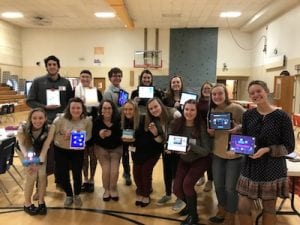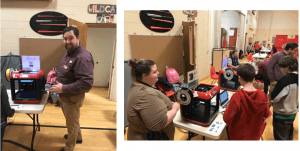Katie King
Elementary Education
Class of 2014
Augusta Schools: 5th Grade Teacher
UMF’s College of Education, Health, and Rehabilitation Services (CEHR) had the chance to connect with Katie King over email to discuss her experiences as a new teacher.

UMF Elementary Education graduate Katie King in her classroom.
UMF CEHR: What was the best experience that you encountered in your UMF education program?
Katie: The best experience I had at UMF in the education program was by far my professors. I loved the connections and relationships that were formed. Even after your class was over you could still go to any of your professors to get advice or just catch up. They truly cared about me as an individual and about me as an educator. This still rings true today as I still keep in contact with many of my professors. It’s nice to have someone who has been in your shoes as a teacher to go to and troubleshoot or gain ideas from. They don’t stop caring about you just because the class is over or you have graduated.
UMF CEHR: What tips can you give our current students who are going to be entering student teaching?
Katie: For students about to enter student teaching they need to embrace the experience. This will probably be the one and only time you can go in and observe multiple professionals in their classrooms without having to get a substitute. Go visit different grades and special education rooms. If ever you have the opportunity to do a book study or participate in something that your mentor is doing, do it too! That’s a great way to get your name out there and show you are a team player. Finally, have fun! Mistakes will happen, lessons will flop, a kid may throw up but these are all real experiences; learn from them and fully take in everything your placement has to offer.
UMF CEHR: The professors are awesome here! What did you find appealing about the school district that you are currently working in?
Katie: Currently, I work for the Augusta School Department. I moved 40 minutes north of my hometown to teach here because I felt like the district’s goals aligned with my own. They want what is best for their students and that’s my end goal. Augusta also has a handful of teachers who graduated from UMF and those with whom I spoke with said they felt prepared to take on the day-to-day role of a teacher within the district because they offered so much support for first year teachers. They offer a mentor with whom you have weekly meetings, they held sessions for new teachers on how to complete the district assessments, they have a literacy and math mentor who came into my room to help me create and execute lessons for my students.
UMF CEHR: Can you explain a time where something did/did not go well, and how did that help you advance as a newer teacher?
Katie: I will never forget during my first year teaching, I had a student who was having such a hard time with a math concept, multiplying double digit numbers. I remembered from my Math methods classes with Dr. Shannon Larsen a strategy we used and when I introduced it to this student the lightbulb moment happened. Due to the fact I had just taken a class two years prior and was fresh out of school, I was able to use what I learned about different ways to teach students. I then was able to share this strategy with my colleagues and I began to feel more confident with myself as an educator. Being a new teacher doesn’t mean you don’t have anything to offer. I found I had a lot to offer my colleagues, just as much as they had to offer me. UMF prepares us well to be educators, being new may mean you have less experience but it doesn’t mean you’re less valuable to a learning community, in fact you do have a lot to offer.
UMF CEHR: Can you talk about the grade you teach and why?
Katie: I chose to be a teacher because I was inspired by my fifth grade teacher, Mrs. Blanchard. She was a first year teacher teaching a 4/5 combination classroom. Her passion and enthusiasm really inspired me to become an educator. When it was time to student teach, I was unsure of which grades I wanted to teach but was given the opportunity to work in a 1/2 combination classroom. I adored those kiddos, but I was able to see the difference between grade levels and realized I enjoyed the second graders because of their free thinking and independence. When hired for my job there was a 1st, 4th or 6th grade opening. While I was familiar with 1st and did my practicum with 6th I wanted to try 4th. I knew there would be the perfect blend of independence and need. I currently teach 5th grade in the same school I started teaching in 2014. I taught 4th for 4 years until a colleague of mine retired and I had such a great class that I chose to go up to 5th grade so I could keep half of my class. I absolutely love my job and the school in which I work. It’s a small school with only two classes per grade level and I love knowing every students’ name and being able to interact with them, even if they are not in my classroom. What I’ve learned about the upper grades is that while the content is harder they are still kids. They still love to have dance parties, love speaking into our classroom microphone and even enjoy the occasional coloring sheet (a multiplication color by number). The best part about teaching older elementary students is their humor. They are slowly becoming their own person and I get to encourage and guide them through that. I also love being a part of their self discovery while they are finding out the best parts of themselves.
UMF CEHR: What great tips! What did you learn from each grade level that you encountered? For our current students in practicum and student teaching, what advice do you have when exploring different ages?
Katie: I have experienced grades 1, 2, 4, 5 and 6 and each one taught me different things. For example, in first and second grade I realized how important play and imagination were. While they are no longer in Kindergarten these students are still young and need time to explore. Students of this age are extremely busy, and these two years are critical in their development, I’m not lying when I say a lot happens academically for them. One of my favorite sayings to our K-2 teachers is that they taught my students how to read so it’s my turn to teach them to love to read. The upper grades of 4, 5 and 6 are definitely my comfort zone. Their independence level is there and while we are working on advanced academics we also are fostering a social/emotional piece that is different than in the lower grades. These years are critical for students and through social-emotional learning we are helping them realize who they truly are and how to interact with others in a kind way.
My advice for those going into the field is to be open to all grades. Go out of your comfort zone, you learn the most when you are uncomfortable because you are forced to explore more. When I decided I wanted to be a teacher I thought I only wanted the littles but my practicum placement was in 6th grade…at a middle school nonetheless! But I’ll tell you what, I loved every minute of it. While I didn’t get adorable hugs from five year old’s and I didn’t have any funny “kidisms” to share at seminar, what I did get was just as amazing. I got to appreciate the independence of these kiddos mixed with their wisdom, opinions and various interests. I loved the upper grades, I was hooked. But when it came to student teaching I wanted the different end of the spectrum. I wanted to make sure the upper grades were for me. So when I got my placement for a 1/2 combination class I was up for the challenge…or so I thought. After my meet and greet with the students I went home and cried, they were going to eat me alive. But after 16 weeks those kiddos proved to be a dream…I learned so much about how students grow academically and socially from that class. It’s due to the fact I was out of my comfort zone that pushed me so hard to be the best littles teacher I could. If you think you know what grade level you want to teach, do the opposite. Make sure you have as much experience in various levels as you can. Not only does the experience look good on a resume, but it also helps your confidence when you’re in your own classroom. I have 18 students in my fifth grade class but they are not all stereotypical fifth graders. Many act well below or beyond their years so having a wide range of experiences allowed me to better serve them where they are at both behaviorally and academically.
UMF CEHR: What have you learned from your first few years of teaching and how did that help you as an educator?
Katie: Finally, I could write a book about all that I’ve learned through my first few years of teaching. Honestly, there are so many things that I learned that have helped me continuously along the way. But there are 3 very important things I have learned. The first is that we are human; we make mistakes, we care too much and that’s okay because at the end of the day as long as you tried your best and gave it your all, your students learned. The second is to find someone who’s like-minded as you within your building or district. This person will be your sounding board for you, they will push you to be a better educator and you can lean on each other in times of need. As a first year teacher I got myself on a couple of committees and started my grad program for curriculum, instruction and assessment. Did I overextend myself? At times, it felt like it but I had people who were in a similar boat and we pushed each other and helped each other every step of the way. The third thing I learned is that being confident in yourself as a professional is key. Some people may try to think they know more than you or have a better way of doing things but it’s your classroom. Having consistent expectations for students will help make your classroom almost run itself. If someone questions you about why you do something a certain way be honest and confident with your answer. You have gone to school to do this job, you are prepared and you can do this. Never doubt yourself, or worse…never let someone make you doubt yourself. You’ve got this!


 The evening was designed to engage elementary students and families in computer science activities and hosted during the Hour of Code week. The evening was very successful and the teachers loved seeing new ideas for integration into their classrooms!
The evening was designed to engage elementary students and families in computer science activities and hosted during the Hour of Code week. The evening was very successful and the teachers loved seeing new ideas for integration into their classrooms!










 behavior.
behavior.






